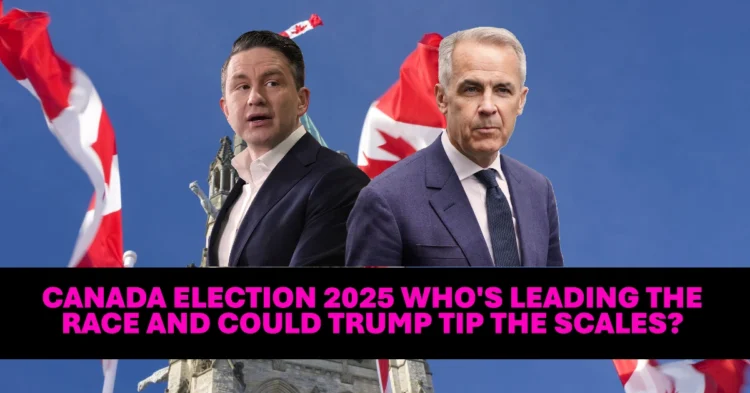As Canada prepares to head to the polls on April 28, 2025, the political landscape is shifting fast—and dramatically. What started as a presumed easy victory for the Conservative Party has transformed into a volatile and unpredictable contest. At the heart of it all? A trade war with the U.S., an increasingly hostile Donald Trump, and the unexpected political rise of Mark Carney, former governor of the Bank of England.
Here’s a full breakdown of what’s unfolding in one of Canada’s most consequential elections in modern history.
Table of Contents
Why Was This Election Called?
Mark Carney, a respected economist with no prior electoral experience, triggered the snap election on March 23 after taking the reins of the Liberal Party from Justin Trudeau. Trudeau stepped down following dismal polling and mounting internal pressure from his own MPs.
Just weeks later, the Liberals—once trailing by double digits—are surging in the polls. The shift comes amidst rising Canadian nationalism, concerns about economic sovereignty, and Trump’s provocative remarks suggesting Canada should become part of the United States.
Who’s Running? The Key Parties in the Race
The Major Players
Canada’s federal election involves four main political parties:
- Liberal Party – Led by Prime Minister Mark Carney
- Conservative Party – Led by Pierre Poilievre
- New Democratic Party (NDP) – Led by Jagmeet Singh
- Bloc Québécois – Led by Yves-François Blanchet
Only the Liberals and Conservatives are projected to have a realistic path to forming a majority government (172 out of 343 seats). Canada operates under a first-past-the-post system, where voters select a local representative (MP) in each riding.
Meet the Frontrunners: Mark Carney vs. Pierre Poilievre
Mark Carney: The Financial Expert-Turned-Politician
At 60, Mark Carney brings a deep background in global finance but zero political campaign experience. He led the Bank of Canada through the 2008 financial crisis and later served as the head of the Bank of England, making history as the first non-British citizen in the role.
Since assuming leadership of the Liberals, Carney has shifted the party slightly to the right—repealing Trudeau’s carbon tax, cutting middle-class taxes, and reversing capital gains increases. Yet he remains committed to climate action and resolving Canada’s housing crisis.
His firm stance against Donald Trump’s tariffs—responding with a bold 25% retaliatory strike—has boosted his credibility as the leader best equipped to handle U.S. aggression. Many Canadians now view him as a steady hand during uncertain times.
“We must respond with both purpose and force,” Carney said in response to Trump’s tariffs.
Pierre Poilievre: The Populist Challenger
Pierre Poilievre, 45, is a career politician and populist who leads the Conservative Party with a “Canada First” message. Known for his aggressive debating style and sharp political instincts, Poilievre rose to prominence under former Prime Minister Stephen Harper.
His campaign focuses on cutting taxes, expanding domestic energy production, and scrapping most of the Liberals’ climate agenda. But his popularity has been hit hard by what’s being called the “Trump effect.”
Trump’s threats of annexing Canada, along with his criticism of Poilievre as “stupidly, no friend of mine,” have complicated the Conservative leader’s appeal, especially as he struggles to distance himself from the American president while keeping Trump-aligned voters onside.
The Trump Factor: A Foreign President Casting a Long Shadow
One of the most disruptive forces in this election isn’t even Canadian. Donald Trump’s escalating rhetoric—including hints that Canada should become the 51st U.S. state—has deeply impacted public opinion.
In fact, a recent CTV News poll showed 36% of voters consider Trump the most important issue in this election, even ahead of the economy.
“This election is about who can stand up to Trump,” Carney said during a heated debate.
Poilievre has tried to shift focus back to domestic issues like affordability and jobs, but many Canadians fear that his policies are too aligned with Trump’s brand of nationalism. Carney, meanwhile, has used this contrast to frame himself as the defender of Canadian sovereignty.
Quebec’s Pivotal Role in the 2025 Election
Quebec, which accounts for 78 parliamentary seats, could be the kingmaker in this election. Historically unpredictable, the province’s vote often swings national results.
Led by Yves-François Blanchet, the Bloc Québécois champions Quebec’s interests. In the last election, they came close to outpacing the Liberals in the province. This year, however, polls suggest growing support for Carney’s Liberals among Quebecers—potentially putting the Bloc and Conservatives neck-and-neck for second place in the region.
With Quebec leaning Liberal, the path to victory for Carney is looking increasingly realistic.
Could Canada’s Identity Be at Stake?
Beyond party platforms and regional votes, this election is being framed as a defining moment for Canada’s national identity. The threat of economic and political domination from the U.S., particularly under a second Trump administration, looms large.
“This is no ordinary election—it’s a referendum on whether Canada remains its own country in practice, not just name,” said one political analyst.
From international trade and economic independence to climate policy and cultural sovereignty, April 28 is shaping up to be more than just a date to choose a leader—it’s a vote for the kind of country Canadians want to be.
Canada Conducts First Healthcare-Focused Express Entry Draw Since July
Calgary Housing Prices Projected to Rise by the End of 2025
Final Thoughts: What to Watch For
- Will Carney’s outsider credibility outweigh Poilievre’s political experience?
- How deeply will Trump influence the Canadian ballot box?
- Will Quebec hold the balance of power?
With just days left, the stakes have never been higher. Whether it’s a rejection of American interference or a shift toward populist conservatism, the outcome of this election will echo far beyond Ottawa.
Election Day: April 28, 2025
All eyes on Canada.

